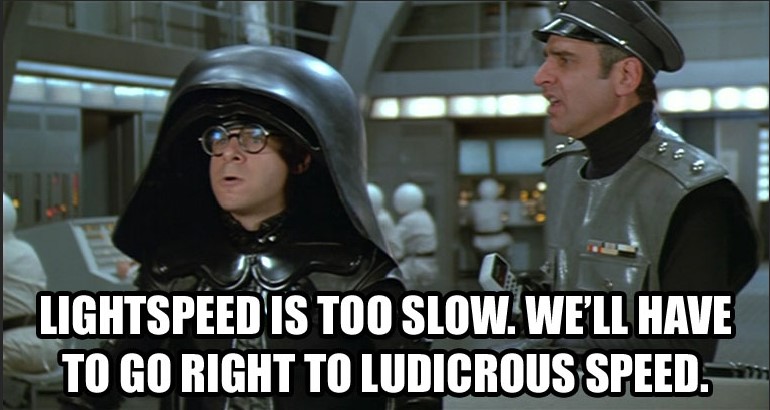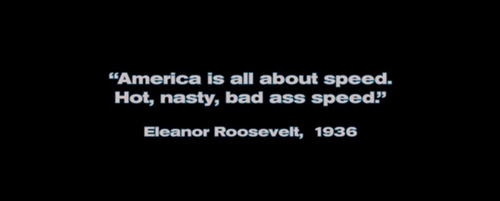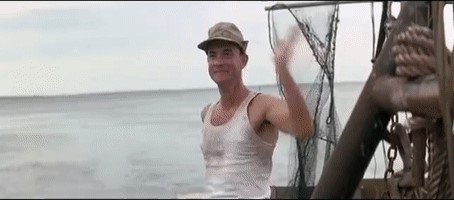There’s a quote attributed to Wyatt Earp that basically says, “Slow is smooth and smooth is fast.” Actually, what he said was “Make haste, slowly.”
There is SOOOOOOO much misinformation on the topic of whether to train fast or slow. To begin with, it’s not a binary, white/black, train slow/train fast issue–it’s a progression, similar to training wheels/no training wheels.
The tongue-in-cheek reply for “cool” shooters to use when someone says, “slow is smooth, smooth is fast.” is “slow is slow.”
Which, seems like gun training wisdom from Spaceballs…

or gun training wisdom from another of my favorite, wisdom filled movies, “Talladega Nights”…

The trick isn’t to do all of your training slowly…it’s that if you shoot so quickly that you miss and have to take a makeup shot, it’s unlikely that you’ll be faster than if you would have taken an extra 1/10th or 2/10ths of a second to make the first shot count.
Put another way, you can’t miss fast enough to win a gunfight.
The lesson also isn’t to focus on a slow first shot…the lesson is that you should train as slow as necessary to make your hits and then work on constantly increasing that speed.
I’ll give you an example…
Less than 10% of shooters who carry regularly, including LE, Mil, instructors, and competitors, can stand at 6-10 feet and shoot a slow-fire 5 round, 1″ group.
That’s not ideal.
That 90% segment of shooters needs to spend time shooting at a speed where they can focus on muzzle alignment and trigger press.
They have fundamental flaws in their technique that need to be addressed before they start building other skills and tactics on top of a bad foundation.
One way to do this is with speed & precision drills.
You can do these with live fire, airsoft, pellet guns, dry fire cord & video, or a Mantis X.
One thing that’s good to know is how fast you can run the trigger without disturbing sight alignment.
How long does it take you to hear the beep, process it as a “go” signal, and send the motor impulse to your finger to press the trigger…without worrying about accuracy.
To test this, you basically set a shot timer with a LONG delay. You hit the timer, and then aim at a small, 1″ bullseye target 6-10 feet away and take up the slack on the trigger. The instant the buzzer goes off, you press the trigger as quickly as possible.
You can test this with live fire, with a SIRT, CoolFire, laser insert, CrimsonTrace style laser sight, OR by reading your sights or red-dot and watching how much your sight alignment shifts during your trigger press.
That tells you the fastest you can shoot and expect to make a 1″ target at 6-10 feet. Let’s say it .40 seconds.
Next, you want to see how quickly you can press the trigger and hit a 1″ target 5x in a row…the reason for this is because it’s natural to throw 3 shots, get lucky on a screaming fast trigger press, and think that you can actually shoot that fast on demand. Doing something fast and accurately 5x in a row squeezes out luck. Let’s say the speed that you can press the trigger without disturbing muzzle alignment is .9 seconds.
Initially, you may need to slow down, and you may need to use a slow, smooth trigger press.
How slow?
However slow you need to press to be able to isolate trigger finger movement and not disturb muzzle alignment. In the example I gave, it would be .9 seconds.
You don’t want to go slow for the sake of going slow…there needs to be a reason for it. You want to go as slow as you need to hit your target and no slower. You want to go as fast as you can and still hit your target and no faster.
The goal of going slow isn’t to go slow…it’s to get the details dialed in so that when you mash on the gas, you can still hit what you want to hit instead of spraying and praying.
At this point, you know how quickly you can press the trigger without disturbing the muzzle (.9 seconds) AND you know the fastest speed that you can press the trigger (.4 seconds).
Out of curiosity, I just did 5 compressed surprise break drills on the Mantis X with my Glock 26 and my times ranged from .21-.30 and my scores ranged from 91.6-97.2. When I just focused on precision, my 5 shot scores were between 96.9 and 98.8
Now, it’s simply a matter of improving the speed at which you can isolate trigger finger movement.
So, once you have a speed where you can line up your muzzle and press the trigger without disturbing muzzle alignment, now you’ve got a foundation to add speed to.

There are LOTS of opportunities to help shave time off of a draw stroke. More than most people realize. I have a 100+ checklist for draw stroke to consistently help shooters get sub-second hits on target from concealment that the Draw Stroke Mastery course is based on. The crazy thing is, focusing on shaving .10 seconds off of a draw stroke isn’t that helpful in a gun fight because of the speed that it gives you…most people would be quicker by focusing on situational awareness and accurate threat profiles…but what measuring speed and group size in training does is give you objective feedback on the efficiency, consistency, and precision of your technique.
You simply can’t draw 5x in a row and make sub-second, -0 hits at 15-21 feet without efficiency, consistency, and precision. People can do a one-off for a highlight video, but not 5x in a row. The quickest way to that efficiency, consistency, and precision is to start slow and add speed over time.
The reason that this efficiency, consistency, and precision is important is that those are all signs that the skill is hardwired into the parts of the brain that you’ll actually have access to under stress AND that they’re coded in such a way that you will be able to execute them at a high level when your conscious mind is consumed with survival and doesn’t have bandwidth to think through the process of shooting.
What about slow speed training carrying over to high speed performance?
That’s complicated, and it’s further complicated by people taking extreme positions, extrapolating, and then going hyperbolic with their examples.
An interesting thing about speed is inertia. Past about .2 splits, your trigger finger has felt inertia and a little overtravel becomes your friend in the form of consistency…because it prevents short stroking. It’s common for shooters who only shoot slow with a perfect reset to short-stroke when they suddenly have to shoot really fast. This is a case where slow training doesn’t carry over to high speed performance…ideally, you’d do a mix of fast and slow training. At a minimum, you’d want to do your slow training through the entire range of motion that you’re going to be using at high speed.
You’ve got inertia around all of your joints as well…wrist, elbow, shoulder, waist…and the fact is, the motor output needed to stabilize a joint is different at low speed than high speed.
Want another layer?…Think about Forest Gump waving his hand. What people see is the arm waving.

That represents 10% of the motor output coming out of the brain…the other 90% is going (mostly) to the other side of the body to maintain balance. (you can click on the image to see a looping .gif of him waving and the compensatory body movement)
The quantity, quality, and flexing of that compensatory muscle tension to maintain balance is very different at low speed and high speed. Low speed=low balance challenge…high speed=high balance challenge.
Interestingly enough, the more wasted movement in the draw stroke, the more challenging it is to maintain balance.
As to slow speed not helping develop high speed…that’s simply a misunderstanding. As a neural pathway gets myelinated, the accuracy and intensity of the signal increases, the excess compensatory muscle activation around joints decreases, and the number of muscle fibers that get activated in a muscle group increases. BUT, you can’t stop with slow speed…once you’ve got the foundation laid, you need/want to start adding speed.
The core concept here is the foundation. Think about cutting a stud with a handsaw.
If you start fast, you’re going to be moving fast, but make several erratic cuts. The cut is going to be sloppy.
If you start slow and create a groove, you can quickly start adding speed. You end up with a single, precise cut AND you cut through the stud quicker.
Again, it’s not a matter of slow vs. fast…it’s a matter of starting slow and progressing to fast.
The big difference between starting fast and trying to add precision later and starting precise and adding speed later is that it’s MUCH easier to execute precise technique quicker than it is to increase precision at full speed. Here’s why…
The big change-point in technique is when people go from closed loop shooting to open loop shooting.
Basically, closed loop shooting is done at a speed where you can think your way through a process and make error corrections (cybernetic) as you’re performing the skill.
Open loop shooting is done at a speed where you decide to execute the action and your brain basically runs a macro that is too fast to make adjustments on…you’re aware of the start-state and the end-state, but everything in-between happens on autopilot.
When world champion shooter, Max Michel, talks about why he does the majority of his practice at slow speed, he says (roughly) that at full speed, you’re aware of the beginning and the end and nothing in between. Practicing at slow speed allows you to focus on the details and refine your technique.
How do you tell the difference between open and closed loop shooting? One way to think about it is the old concept of “takebacks.” There are no takebacks with open loop technique. Once you start executing, it happens faster than your ability to process sensory input and change or stop the action. At blazing-fast reaction times, that speed is somewhere between .2 and .75 seconds, depending on whether you’re reacting to visual, audible, or tactile input.
With closed loop technique, there’s time to assess and adjust.
So, which should you do?
Both.
It’s possible to start with speed and then try to back your way into better technique, but it’s a long, hard, expensive road.
The quality of your performance with FAST open loop shooting depends on the quality of the “macros” that you’ve created and, ironically, the best macros are created at slow speed.
The general training pattern is:
1. Start slow and precise
2. Add speed until precision starts dropping off.
3. Over time, that speed where your precision starts dropping off will keep getting faster and faster.
4. When you get to the speed you want in sterile conditions, slow down, add complexity, and start the process of adding speed again.
Following this process, you can quickly go from a shooter who is able to shoot accurately in slow, sterile conditions to one who is able to shoot accurately in fast, chaotic conditions.
If you’re interested in a fun, at home, step-by-step process for shooting better at high speed in chaotic conditions than most people can plink cans standing flat footed, then I want you to check out the encore Dynamic Gun Fighter presentation that we’re doing this week, >HERE<
You’ll learn some VERY high speed training techniques that you can begin using immediately AND we’ve got some cool gifts that you’ll receive, just for attending.
Make sure to stay to the end to see how you can get a free set of 3 Pop-Up targets!
So…what are your questions on training fast or training slow? Fire away by commenting below.
Leave A Response